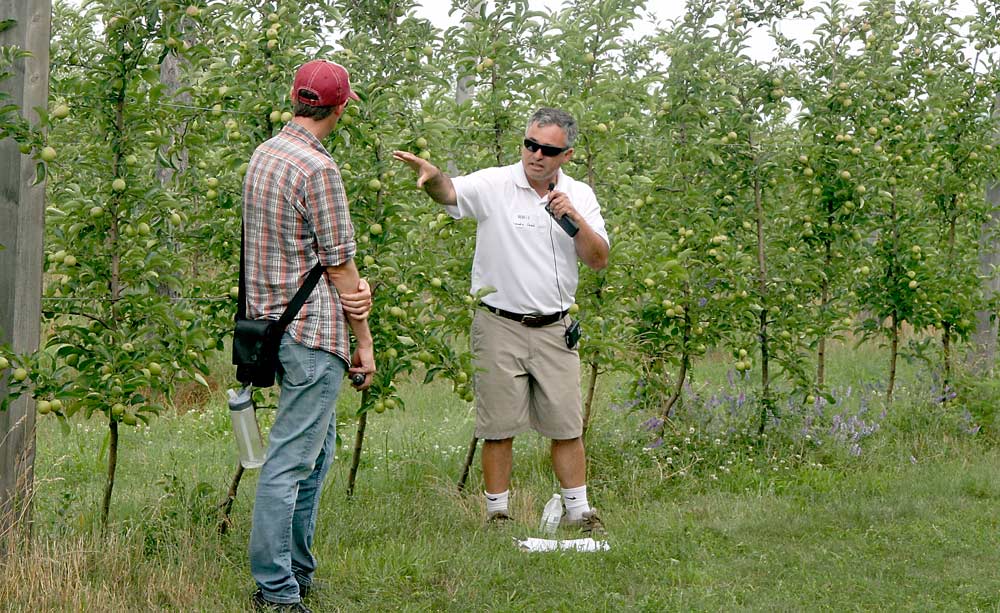
Mario Miranda Sazo, right, and Jaume Lordan, both from Cornell University, discuss the need for irrigation in high-density apple systems in an organic GoldRush block at Bittner-Singer Farm in Appleton, New York. (Kate Prengaman/Good Fruit Grower)
The only consistency on the Lake Ontario Fruit Program tour this summer was the humidity.
Otherwise, the five-farm tour organized by Cornell University Cooperative Extension covered a remarkably diverse swath of tree fruit farming in a narrow band along Lake Ontario’s shores: new high density apple plantings and apple orchards far older than this reporter, along with high density peaches, berries, and a brand new cidery.
Many of the presentations from Cornell researchers focused on maximizing the success of new high-density apple plantings, including precision irrigation, nutrition, and chemical thinning.
“You have to babysit the trees from the get-go,” said extension specialist Mario Miranda Sazo. He encouraged all growers to include drip irrigation systems with new plantings whenever possible. After last year’s drought, more growers are considering the investment, he added.
With more trees, bigger apples, and smaller root systems in high-density plantings, it’s much easier for trees to end up water stressed, said Jaume Lordan, a postdoctoral researcher, and that can lead to other problems. “If there is no water, you can keep putting out nutrients, but they will not be taken up,” he said.
Irrigation is especially critical for growing organically, said grower Jim Bittner, when the tour visited his 4-acre organic GoldRush block in Appleton, New York. Growing organic isn’t easy in the Northeast, but he’s figured out how to make it work for the processing market, he said.
“People say they want organic but the truth of the matter is they still want perfection,” Bittner said, adding that he chose to plan apple scab resistant varieties for organic management, but still struggles with some pests such as codling moth.
Pest control was a primary topic on the tour, including increasing reports of Brown Marmorated Stink Bugs and potential reports of damage from the invasive pest in Western New York, one grower’s recent struggle with leopard moth in a new apple orchard, and spotted wing drosophila control options for berries and cherries.
The tour ended at West Wind Fruit Farm, a u-pick farm that’s poised to open a new cidery in the coming weeks. Owners Jeremy and Jill Wolfe say their goal was to diversify their farm as much as possible to reduce risk and after adding cane berries, blueberries, and stone fruit in addition to their 16 acres of u-pick apples, the next step was the “crazy idea” to take their cider making to a commercial scale.
Cider has been booming business in New York in the past decade and growth appears to be slowing to a more stable pace, said Greg Peck of Cornell. But ample opportunity remains for growers to expand into cider-specific varieties that could be grown in a low-input, processing style orchard, once the ideal varieties for growing in Western New York are identified, he said.






Leave A Comment